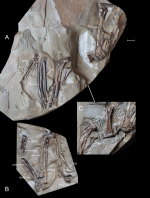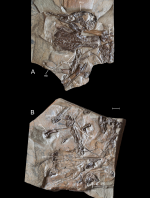SYSTEMATIC PALAEONTOLOGY
Class AVES Linnaeus, 1758
Order ANSERIFORMES Wagler, 1831
Family ANATIDAE Leach, 1819
Genus
LAVANTTALORNIS gen. nov.
zoobank.org/9592EB4E-37D8-457E-881B-0DBAA710D6EF
Type species. Lavanttalornis hassleri gen. et sp. nov.
Etymology. After the Lavanttal valley where the specimen was found, added to the Ancient Greek ὄρνις (órnis) meaning “bird”.
Taxonomic remarks. The new species resembles Anatidae in overall morphology and a unique combination of the following characters: the end of the beak bears foramina neurovascularia; the shape and proportions of the pelvis correspond to those of anatids; the coracoid bears a deeply concave cotyla scapularis of a rounded-triangular shape, short processus procoracoideus, and laterally protruding facies articularis humeralis; the humerus bears the facet of the tuberculum supracondylare ventrale that is cranially buttressed and tilted distally, and there is no prominent tuberculum supracondylare dorsale; in tibiotarsus, the condylus medialis projects much medially in relations to distal shaft, and lateral side of distal shaft forms a sharp edge that slants anteriorly towards condylus lateralis.
Differential diagnosis. Lavanttalornis hassleri gen. et sp. nov. is distinguished from:
- Mionetta blanchardi (Milne-Edwards, 1863), from the late Oligocene to middle Miocene of Europe, in: coracoid with medial margin of the omal section of the shaft strongly inclined medially and almost straight, processus acrocoracoideus hardly protruding beyond the medial margin of shaft, and facies articularis sternalis almost straight, humerus with roundish condylus ventralis, and distal end expanded little ventrally, and relatively wide phalanx proximalis digiti majoris with bulging caudal edge;
- Mionetta consobrina (Milne-Edwards, 1867–1868), from the early Miocene of Europe, in: coracoid with medial margin of the omal section of the shaft strongly inclined medially and almost straight, and processus acrocoracoideus hardly protruding beyond the medial margin of shaft;
- Mionetta natator (Milne-Edwards, 1867–1868), from the late Oligocene to early Miocene of Europe, in: coracoid with medial margin of the omal section of the shaft strongly inclined medially and almost straight, processus acrocoracoideus hardly protruding beyond the medial margin of shaft, and facies articularis sternalis almost straight;
- Miotadorna sanctibathansi Worthy, Tennyson, Jones, McNamara, and Douglas, 2007, from the early middle Miocene of New Zealand, in: coracoid with facies articularis sternalis almost straight, and humerus with distal end expanded little ventrally;
- Manuherikia Worthy, Tennyson, Jones, McNamara, and Douglas, 2007, and Dunstanetta Worthy, Tennyson, Jones, McNamara, and Douglas, 2007, from the early middle Miocene of New Zealand, in: coracoid with medial margin of the omal section of the shaft strongly inclined medially and almost straight, and humerus with relatively thick shaft that does not narrow distally;
- Pinpanetta Worthy, 2009, from the late Oligocene/early Miocene of Australia, in: coracoid with medial margin of the omal section of the shaft strongly inclined medially and almost straight, and processus acrocoracoideus hardly protruding beyond the medial margin of shaft;
- Sharganetta mongolica Zelenkov, 2011, Nogusunna conflictoides Zelenkov, 2011, and Protomelanitta gracilis Zelenkov, 2011, from the middle Miocene of Mongolia, in: humerus with shallow notch of incisura capitis in proximal outline of the bone, and distal end expanded little ventrally;
- Chenoanas deserta Zelenkov, 2012b, and Chenoanas asiatica Zelenkov, Stidham, Martynovich, Volkova, Li, Qui, 2018, both from the middle Miocene of eastern Russia and Mongolia, Chenoanas sansaniensis (Milne-Edwards, 1867–1868), from the early to middle Miocene of Europe, eastern Russia and Mongolia, Aix praeclara Zelenkov et Kurochkin, 2012, Mioquerquedula soporata (Kurochkin,
1976), and
Mioquerquedula minutissima Zelenkov et Kurochkin, 2012, all from the middle Miocene of Mongolia, and
Protomelanitta
velox (Milne-Edwards, 1867), from the middle Miocene of France, in: coracoid with medial margin of the omal section of the shaft strongly inclined medially and almost straight, and processus acrocoracoideus hardly protruding beyond the medial margin of shaft;
*
Aythya denesi (Kessler, 2013) from the late Miocene of Hungary, and
Bambolinetta lignitifila (Portis, 1884) from the late Miocene of
Italy, in: humerus with relatively thick shaft that does not narrow distally;
- Aythya shihuibas Hou, 1985, from the late Miocene of China, and Aythya molesta (Kurochkin, 1985), from the late Miocene of Mongolia, in: humerus with shallow notch of incisura capitis in proximal outline of the bone;
- Matanas enrighti Worthy, Tennyson, Jones, McNamara and Douglas, 2007, from the early-middle Miocene of New Zealand, in:
coracoid with processus acrocoracoideus hardly protruding beyond the medial margin of shaft;
*
Anas kurochkini Zelenkov et Panteleyev, 2015, from the late Miocene of northeastern Sea of Azov region, Russia, in: coracoid with medial margin of the omal section of the shaft strongly inclined medially and almost straight, thick crista acrocoracoidea, facies articularis humeralis with acute cranial angle and projecting
little laterally, and facies articularis sternalis almost straight;
* all extant ducks by a unique combination of characters: coracoid with medial margin of the omal section of the shaft strongly inclined medially and almost straight, ventral plane of processus acrocoracoideus subparallel to the ventral plane of the extremitas sternalis, processus acrocoracoideus hardly protruding beyond the medial margin of shaft, and facies articularis sternalis almost straight, humerus with distal end expanded little ventrally, and relatively wide phalanx proximalis digiti majoris with bulging caudal edge.
Lavanttalornis hassleri sp. nov.
zoobank.org/9E7230E3-FC50-4AE6-987B-E1F0DD6C7C95
Etymology. The species is named after the finder of the specimen, Dr. Andreas Hassler of Sankt Andrä, a veterinarian by profession but a paleontologist by passion.
Holotype. LMK-Pal 7453a+a’+b+c+d, partly articulated nearly complete skeleton on four slabs from which the right coracoid has been removed, cleaned and is visible as a 3D object; housed at the paleontological collection of the Landesmuseum Kärnten (LMK-Pal), Klagenfurt, Austria.
Type locality and horizon. A site near the village of Schaßbach, about 50 km northeast of Klagenfurt in the Lavanttal, Carinthia, southern Austria. GPS coordinates using WGS 84 datum: 46.79752°N 14.80676°E at an altitude of 471 m above sea level. The specimen is dated to the Upper Sarmatian s. s. (upper middle Miocene), ca 12 Ma. It was found in freshwater sediments that contain two coal seams lying above the Middle Sarmatian layers (Reischenbacher et al., 2007).
Diagnosis. As for the genus.
Measurements. Measurements (in mm) including total length (TL) and others, taken from slabs A, B or C: coracoid (A, dext) TL, 47.6, medial length, 42.4, sternal width, 17.7; scapula (A, sin) articular height, 11.2; humerus (A, sin) TL, 75.5, proximal width, 18.7, distal width, 10.6, least shaft width, 6.3; radius (B, dext) TL, 62.6; ulna (B, dext) TL, 69.5; carpometacarpus (B, dext) TL, 46.4, proximal width, 11.9; phalanx proximalis dig. majoris (B, dext) TL, 19.6; phalanx dig. minoris (B, dext) TL=9.6; pelvis (C) TL, 64.4, width between antitrochanters, 30.5.
Fred
FIGURE 1. Lavanttalornis hassleri gen. et sp. nov., holotype, specimen LMK-Pal 7453a+b from Lavanttal, Austria, middle Miocene. A, slab A after exposing all the bones and removing the coracoid; B, slab B (counterslab of the wing bones visible on slab A); C, fragment of slab A before removal of the coracoid. Abbreviations: lcs, left scapula; lhu, left humerus; rcm, right carpometacarpus; rco, right coracoid; rcs, right scapula; rhu, right humerus; rmin, right phalanx digiti minoris; rpda, right phalanx digiti alulae; rpdm, right phalanx proximalis digiti majoris; rra, right radius; rul, right ulna. Scale bar equals 10 mm.
 FIGURE 2. Lavanttalornis hassleri
FIGURE 2. Lavanttalornis hassleri gen. et sp. nov., holotype, specimen LMK-Pal 7453c+d from Lavanttal, Austria, middle Miocene. A, slab C; B, slab D (counterslab of slab C). Abbreviations: lcm, left carpometacarpus; lfe, left femur; ltb, left tibiotarsus; pel, pelvis; rfe, right femur; rtb, right tibiotarsus; sku, skull; ver, vertebrae. Scale bar equals 10 mm.







